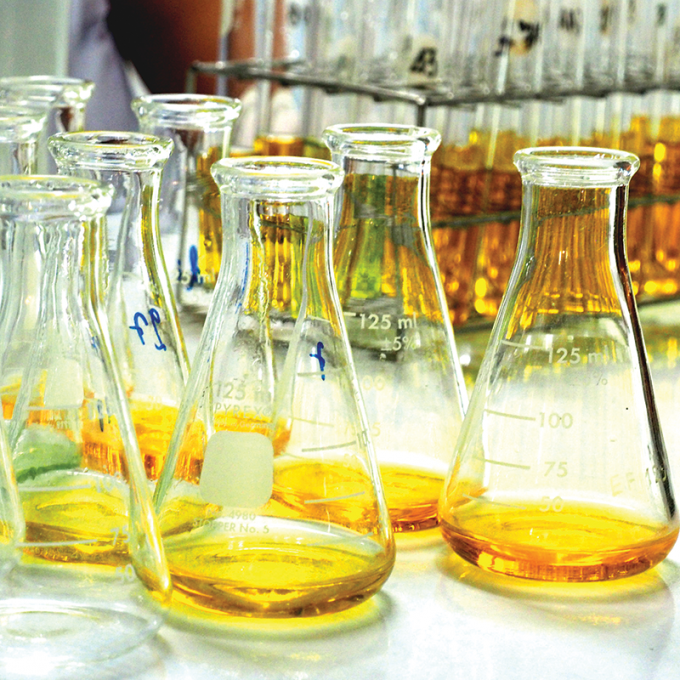Selected Publications
L. L. Dugan, D. M. Turetsky, C. Du, D. Lobner, M. Wheeler, R. Almli, C. K.-F.Shen, T.-Y. Luh, D. W. Choi, and T.-S. Lin, "Carboxyfullernes as Neuroprotective Agents", Proc. Natl. Acad. Sci., 94, 9434 -9439 (1997).
Jun Lang, David J. Sloop, and Tien-Sung Lin, "Dynamics of p-terphenyl crystals at the phase transition temperature: A zero-field EPR study of the photo-excited triplet state of pentacene in p-terphenyl crystals" J. Phys. Chem. - A, 111, 4731- 4736 (2007).
Tomoaki Yago, Tien-Sung Lin, Gerhard Link, and Gerd Kothe, "Pulsed Electron Nuclear Double Resonance Studies of the Photo-excited Triplet State of Pentacene in p-Terphenyl Crystals at Room Temperature" J. Chem. Phys. 127, 114503 ( 2007).
Chia-Hung Lee, Tien-Sung Lin, and Chung-Yuan Mou, "Mesoporous Materials for Encapsulating Enzymes" Nano Today 4, 165-179 (2009).
Chia-Hung Lee, Han-Chou Lin, Tien-Sung Lin, and Chung-Yuan Mou, "Reactivity Study of Hydroxo-Bridged Dinuclear Cupric Complexes Encapsulated in Mesoporous Silica: Model Compounds for Catechol Oxidases", J. Phys. Chem. - C 113, 16058-16069 (2009).
Kun-Che Kao, Chia-Hung Lee, Tien-Sung Lin, and Chung-Yuan Mou, "Cytochrome c covalently immobilized on mesoporous silicas as a peroxidase: Orientation effect", J. Mater. Chem. 20, 4653 - 4662 (2010).
Gerd Kothe, Tomoaki Yago, Jörg-Ulrich Weidner, Gerhard Link, Michail Lukaschek, and Tien-Sung Lin, "Quantum Oscillations of Nuclear Spins in Photo-excited Triplet States", J. Phys. Chem. B, 114, 14755-14762 (2010).
Ya-Cheng Fang, Chia-Hung Lee, I-Jui Hsu, Tien-Sung Lin, and Chung-Yuan Mou, “Bio-inspired Design of a Cu-Zn-Imidazolate Mesoporous Silica Catalyst System for Superoxide Dismutation”, J. Phys. Chem. C, 115, 20639-20652 (2011).
Raghavan Rajagopalan, Tien-Sung Lin, Amolkumar S. Karwa, Amruta R. Poreddy, Bethel Asmelash, and Richard B. Dorshow, “Type 1 Phototherapeutic Agents, Part II: Cancer Cell Viability and ESR Studies of Tricyclic Diarylamines”, ACS Medicinal Chemistry Letters, 3, 284-288 (2012).
Xiaoyan Liu, Ming-Han Liu, Yi-Chia Luo, Chung-Yuan Mou, Shawn Lin, Hong Cheng, Jin-Ming Chen, Jyh-Fu Lee, Tien-Sung Lin, “Strong metal-support interactions between gold nanoparticles and ZnO nanorods in CO oxidation”, J. Am. Chem. Soc. 134, 10251-10258 (2012)
Kun-Che Kao, Tien-Sung Lin, and Chung-Yuan Mou, “Enhancing Activity and Stability of Lysozyme by Immobilization in the Mesoporous Silica Nanoparticles”, J. Phys. Chem. - C 118, 6734−6743 (2014).
Po-Yeng Feng, Yi-Hung Liu, Tien-Sung Lin, Shie-Ming Peng, and Ching-Wen Chiu, “Redox Chemistry of a Hydroxylphenyl-Substituted Borane”, Angew. Chem. Int. Ed. 53, 6237-6240 (2014).
Chih-Cheng Liu, Tien-Sung Lin, Sunney Chan and Chung-Yuan Mou, “A Room Temperature Catalyst for Toluene Aliphatic C-H bond Oxidation: Tripodal Tridentate Copper Complex Immobilized in Mesoporous Silica”, J. of Catalysis, 322, 139-151 (2015).
Qingbo Yang, Tien-Sung Lin, Casey Burton, Sung-Ho Park and Yinfa Ma, “Physicochemical Insights of Irradiation Enhanced Hydroxyl Radical Generation from ZnO Nanoparticles”, Toxicol. Res., 5, 482-491 (2016).
Li-Chung Yu, Gene-Hsiang Lee, Marc Sigrist, Tien-Sung Lin and Shie-Ming Peng, “Structure and antiferromagnetism of trinuclear heterometallic strings containing MnII–MII–MnII frameworks (M = Ni, Pd, Pt)”, Euro. J. Inorg. Chem. 2016, 4250-4256 (2016).
Chun-Chieh Wang, Hao-Ching Chang, Yei-Chen Lai, Huayi Fang, Chieh-Chin Li, Hun-Kai Hsu, Zong-Yan Li, Tien-Sung Lin, Ting-Shen Kuo, Shengfa Ye, Yun-Wei Chiang, Ming-Li Tsai, Wen-Feng Liaw, and Way-Zen Lee, “A Structurally Characterized Nonheme Cobalt-Hydroperoxo Complex Derived from its Superoxo Intermediate via Hydrogen Atom Abstraction”, J. Am. Chem. Soc.138, 14186–14189 (2016).
Wei-Chun Liu, Yi-Hung Liu, Tien-Sung Lin, Shie-Ming Peng and Ching-Wen Chiu, “1,2-Migration of N-Diarylboryl Imidazol-2-ylidene through Intermolecular Radical Process”, Inorganic Chemistry, 56, 10543-10548 (2017).
Tien-Sung Lin, Invited paper, “Novel Pulsed Electron Paramagnetic Resonance Techniques for the Studies of Structure and Dynamics of Photo-excited Triplet State of Organic Molecules: A Professional Journey”, J. Chinese Chem. Soc. (Taiwan), 65, 163-188 (2018).
Ming-Han Liu, Yun-Wen Chen, Tien-Sung Lin, Chung-Yuan Mou, “Defective Mesocrystal ZnO-Supported Gold Catalysts: Facilitating CO Oxidation via Vacancy Defects in ZnO", ACS Catalysis 8, 6862-6869 (2018)
Cheng-Chang Chiu, Gene-Hsiang Lee, Tien-Sung Lin and Shie-Ming Peng, “Ligand Effects on the Structure, Mixed-valence Sites and Magnetic Properties of Novel Pentanickel String Complexes”, Dalton Trans, 48, 8464-8477 (2019).
Ming-Chuan Cheng, Rui-Xiang Huang, Yu-Chiao Liu, Ming-Hsi Chiang, Gene-Hsiang Lee, Tien-Sung Lin and Shie-Ming Peng, “Structures and paramagnetism of five heterometallic pentanuclear metal strings containing as many as four different metals: NiPtCo2Pd(tpda)4Cl2”, Dalton Trans., 49, 7299-7303 (2020) (on journal cover).
Chi Li, Sheng-Chih Hsu, Jun-Xiao Lin, Jou-Yun Chen, Yuan-Pin Chang, Hua Shu Hsu, Ching-Hsiang Chen, Tien-Sung Lin, and Yi-Hsin Liu, “Giant Zeeman Splitting in Monolayer Nanosheets at Room Temperature” J. Am. Chem. Soc. 142, 20626-20623 (2020).
Gerd Kothe, Michail Lukaschek, Tomoaki Yago, Gerhard Link, Konstantin L. Ivanov, Tien-Sung Lin, “Initialization of 214 14-qubit entangled nuclear spin states in a hyperpolarized molecular solid" Journal of Physical Chemistry Letters, 12, 3647-3654 (2021).
Ming-Chuan Cheng, Chien-Hung Cheng, Po-Jung Chen, Tien-Sung Lin, Gene-Hsiang Lee, Yu-Chiao Liu, Ming-Hsi Chiang, and Shie-Ming Peng, “Helical homometallic trinickel string complexes with mixed hard nitrogen and sulfur donors: structural and magnetic studies”, Bulletin of the Chemical Society of Japan, 94, 2092-2099 (2021).
Shie-Ming Peng, Tien-Sung Lin, Chun-hsien Chen, Ming-Chuan Cheng, and Geng-Min Lin, “From metal-metal multiple bonds to helical metal strings”, a book chapter in “Ladder Polymers: Synthesis, Properties, Application, and Perspectives” 349-400 (2023) (Editors: Yan Xia, Masahiko Yamaguchi, and Tien-Yau Luh (Wiley-VCH,NY).


